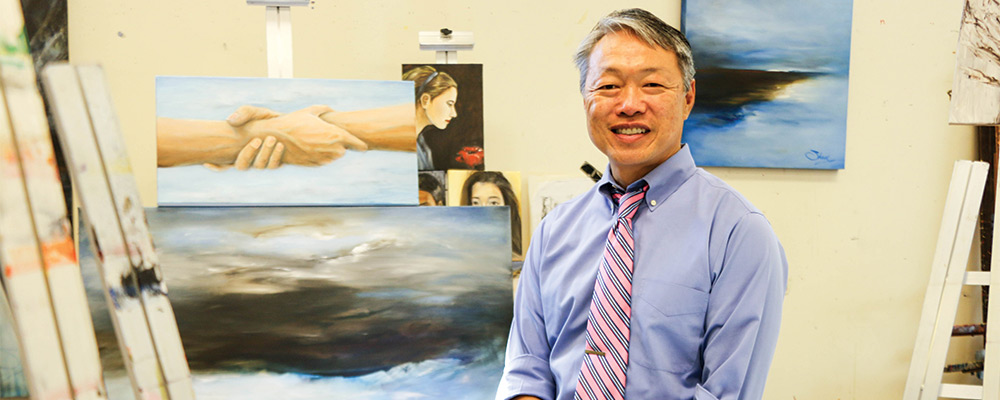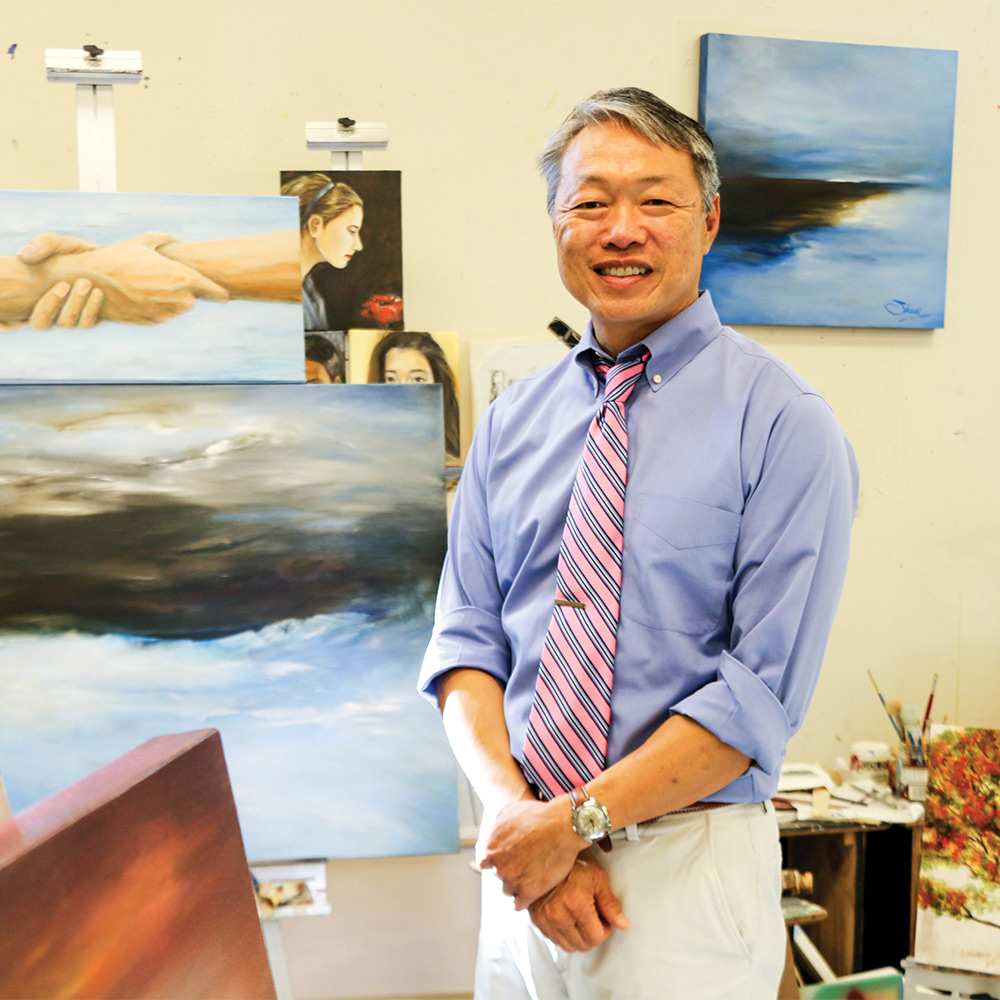It's also a pretty good metaphor for how an artist views his work. "Art is something that is truly uplifting for one spirit, whether that's painting, gardening, or doing a crossword puzzle," says Shen '86 who has taught art at Holland Hall, a college preparatory school in Tulsa, Okla., since 1997. "It's very rarely that you encounter something that gives you the opportunity to continue to learn. If I was a dancer, I think I would have had to find something else to do after I reached 30."
Byron's art and life in some ways reflect his search for new experiences and challenges. Indeed, a short biographical video of Byron's work and philosophy of art is called The Journey (available on his website (byronshen.net).
Byron's own trek toward his true calling started in Hong Kong, when he traveled at age 3 with his mother as she attended the Art Institute of Pittsburgh. She was able to work in art for a short time, but eventually, after the family moved to Chevy Chase, Md., she became a stockbroker at the Washington, D.C. offices of Merrill-Lynch.
Byron liked art, but he wasn't the kind of student who filled page after page with sketches during his free time. "I was taking a lot of upper-level math and science and as a way to relax, I took an art class. It was my stress-buster."
When it came time to look at colleges, he put an art portfolio together and to his surprise he was accepted at the School of the Art Institute of Chicago, one of the top five art schools in the nation. "It did not have dorms, so students had to find their own housing and live in downtown Chicago, so I decided to look at other colleges," he says.
What attracted Byron to Juniata was its dedication to ensuring a well-rounded liberal arts education. "If I had my way, I would have stayed at Juniata eight or 10 years so I could take all the different courses I wanted to fit in," he says.
The focus for most of his undergraduate career was not art. Instead he took as many literature courses as he could. He loved scheduling Mark Hochberg's early morning classes and has vivid memories of Juniata's longtime literature professor trudging in, throwing a leg up on the desk, and taking the class through a Nathaniel Hawthorne classic.
Byron admits his academic career did not get off to a propulsive start. He went on academic probation in his first year, although his solution was unique. He decided to pile on the credit hours each semester. "It left me with no time except for school and studying," he laughs.
One unintended outcome of such a heavy class load was that Byron was able to graduate early. That left his time to do an independent study course. He had taken a ceramics course or two with ceramicist Jack Troy, but it was the painting courses he took with Alexander "Sandy" McBride that struck his imagination.
"I worked with Sandy and he would paint in one area and I would work in the other," Byron remembers. "Sandy let me develop. A huge part of art is about learning to think. Many students can reproduce an assignment but Sandy allowed me to develop my own style. He informed much of the way I teach today."
While he was honing his artistic skills, Byron still had not chosen which path to follow, literature or visual art. "When you read great writers their work transports you to different places and different situations as you read it. That appealed to me," he says. In his senior year he applied to the University of Iowa Writer's Workshop, but was turned down.
When Byron left Juniata in 1986, however, he had secured one of the rarest opportunities available to an artist—a slot at graduate school in the Cranbrook Academy of Art. Cranbrook, located in Bloomfield Hills, Mich. is another of the top five art schools in the nation.
Although Juniata provided Byron the chance to explore art, philosophy, literature, and other topics, he was well behind most of his Cranbrook classmates. Typically graduate art students have spent four to five years in curricula focused just on art. "I spent every hour in the studio or in the library," he says. "Cranbrook is an amazing place that lets you interact with 150 students from across the world. Juniata allowed me a well-rounded background I could draw upon."
Shortly after graduating from Cranbook in 1988, Byron agreed to teach a bunch of first-graders at the Pontiac Center in Pontiac, Mich. The experience energized him. Over the next few years Byron taught classes on more or less a freelance basis. Eventually his path led him to a job as caretaker for Villa Philbrook, a mansion formerly owned by Tulsa-based oil millionaire Waite Phillips.
The mansion job gave Byron the flexibility to pursue his own art, while teaching a few classes and "watching my son grow up." By 1997, he was ready to commit more time to teaching and he started as a part-time art teacher at Holland Hall. By 2000, he had become a full-time faculty member. "It's a unique place," he says of the school. It's sort of like It's a Wonderful Life."
These days, Byron splits his time between teaching, family, and his own art career. He has his own website, www.byronshen.net, and he is represented by the M.A., Doran Gallery in Tulsa and Wilson Adams Gallery in Denver, Colo. His work is in several museum permanent collections and Oklahoma's Gov. Mary Fallin recently purchased one of his paintings.
Finding his path in life has been enjoyable and he would like to continue to explore art beyond the horizon of his experience. He credits the College with helping satisfy his innate curiosity and has tried to use those same tenets in his own teaching.
"Like Juniata, art is all about finding the individual," he explains. "It's not like there is only one way to paint."
"It's very rarely that you encounter something that gives you the opportunity to continue to learn."Byron Shen '86









